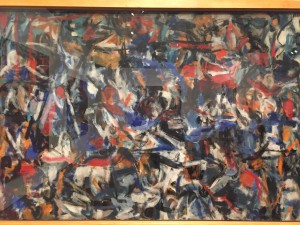Questions, Proxies, and Health
When faced with a difficult question, we often substitute a simpler question and answer that instead. Here are three examples:
- What’s the crime rate in your neighborhood? – We probably don’t keep close tabs on the crime rate. We’re not naturally good at statistics either so it’s difficult to develop a reasonable estimate. So we substitute a different question: How easy is it for me to remember a crime committed in my neighborhood? If it’s easy to remember, we guess that the neighborhood has a high crime rate. If it’s hard to remember, we guess a lower rate. (I’ve adapted this example from Daniel Kahneman’s book, Thinking Fast and Slow).
- How’s your car running? – It’s hard to know how well a car is running in this age of sophisticated electronics. So we answer a different question: How does the car sound? If it’s not making strange noises – knocks and pings – it must be running well and performing optimally.
- How effective is your shampoo? – I suppose we could study our hair’s health every day but most of us don’t. So we answer a simpler question: How much lather does your shampoo produce? If we get a lot of lather, the shampoo must be effective.

How many do I need to get 10 calories of energy?
In each case, we substitute a proxy for the original question. We assume that the proxy measures the same thing that the original question aimed to measure. Sometimes we’re right; sometimes we’re wrong. Most often, we don’t think about the fact that we’re using a proxy. System 1 does the thinking for us. But we can, in fact, bring the proxy to System 2 and evaluate whether it’s effective or not. If we think about it, we can use System 2 to spot errors in System 1. But we have to think about it.
As it happens, System 1 uses proxies in some situations that we might never think about. Here’s an example: How much food should you eat?
(The following is based on a study from the University of Sydney. The research article is here. Less technical summaries are here and here).
We tend to think of food in terms of quantity. System 1 also considers food as a source of energy. System 1 is trying to answer two questions: 1) How much energy does my body need? 2) How much food does that translate to?
Our bodies have learned that sweet food delivers more energy than non-sweet food and can use this to translate from energy needs to food requirements. Let’s say that the equation looks something like this:
1 calorie* of energy is generated by 10 grams of sweet food
Let’s also assume that our body has determined that we need 10 calories of energy. A simple calculation indicates that we need to eat 100 grams of sweet food. Once we’ve eaten 100 grams, System 1 can issue a directive to stop eating.
Now let’s change the scenario by introducing artificial sweeteners that add sweetness without adding many calories. The new translation table might look like this:
1 calorie of energy is generated by 30 grams of artificially sweetened food
If we still need 10 calories of energy, we will need to eat 300 grams of artificially sweetened food. System 1 issues a directive to stop only after we’ve eaten the requisite amount.
System 1 can’t tell the difference between artificially and naturally sweetened foods. It has only one translation table. If we eat a lot of artificially sweetened food, System 1 will learn the new translation table. If we then switch back to naturally sweetened foods, System 1 will still use the new translation table. It will still tell us to eat 300 grams of food to get 10 calories of energy.
We would never know that our brain makes energy/quantity assumptions if not for studies like this one. It’s not intuitively obvious that we need to invoke System 2 to examine the relationship between artificial sweeteners and food intake. But like crime rates or cars or shampoos, we often answer different questions than we think we’re answering. To think more clearly, we need to examine our proxies more carefully.
*It’s actually a kilocalorie of energy but we Americans refer to it as a calorie.
Male Chauvinist Machines

Yanks win last night?
Do men and women think differently? If they do, who should develop artificial intelligence? As we develop AI, should we target “feminine” intelligence or “masculine” intelligence? Do we have enough imagination to create a non-gendered intelligence? What would that look like?
First of all, do the genders think differently? According to Scientific American, our brains are wired differently. As you know, our brains have two hemispheres. Male brains have more connections within each hemisphere as compared to female brains. By contrast, female brains have more connections between hemispheres.
Men, on average, are better at connecting the front of the brain with the back of the brain while women are better at connecting left and right hemispheres. How do these differences influence our behavior? According to the article, “…male brains may be optimized for motor skills, and female brains may be optimized for combining analytical and intuitive thinking.”
Women and men also have different proportions of white and gray matter in their brains. (Click here). Gray matter is “…primarily associated with processing and cognition…” while white matter handles connectivity. The two genders are the same (on average) in general intelligence, so the differences in the gray/white mix suggest that there are two different ways to get to the same result. (Click here). Women seem to do better at integrating information and with language skills in general. Men seem to do better with “local processing” tasks like mathematics.
Do differences in function drive the difference in structure or vice-versa? Hard to tell. Men have a higher percentage of white matter and also have somewhat larger brains compared to women. Perhaps men need more white matter to make connections over longer distances in their larger brains. Women have smaller heads and may need less white matter to make the necessary connections — just like a smaller house would need less electrical wire to connect everything. Thus, a larger proportion of the female brain can be given over to gray matter.
So men and women think differently. That’s not such a surprise. As we look ahead to artificial intelligence, which model should we choose? Should we emphasize language skills, similar to the female brain? Or local processing skills, similar to the male brain? Should we emphasize processing power or information integration?
Perhaps we could do both, but I wonder how realistic that is. I try to imagine what it would be like to think as a woman but I find it difficult to wrap my head around the concept. As a feminist might say, I just don’t get it. I have to imagine that a woman trying to think like a man would encounter similar difficulties.
Perhaps the best way to develop AI would involve mixed teams of men and women. Each gender could contribute what it does best. But that’s not what’s happening today. As Jack Clark points out, “Artificial Intelligence Has A “Sea of Dudes’ Problem”. Clark is mainly writing about data sets, which developers use to teach machines about the world. If men choose all the data sets, the resulting artificial intelligence will be biased in the same ways that men are. Yet male developers of AI outnumber females by a margin of about eight-to-one. Without more women, we run the risk of creating male chauvinist machines. I can just hear my women friends saying, “Oh my God, no!”
The Art Of Transformation
 What’s the difference between an art and a craft?
What’s the difference between an art and a craft?
A traditional definition focuses on differences in expectations and outcomes. With a craft, we know precisely what the outcome will be, even before we start. We have a set of instructions and, if followed faithfully, the outcome is guaranteed.
By contrast, an artist doesn’t know what the outcome will be. Creating an artwork involves exploration, doubt, questioning, trial-and-error, and no small amount of anxiety. An artist explores the unknown and aims to give us new insights. A good artwork may not be beautiful in a classic sense, but it is always imaginative. A craftsman, on the other hand, creates the expected and delivers beauty and pleasure through execution more than imagination.
I thought of these distinctions the other day when I toured a major new exhibition, Women of Abstract Expressionism*, at the Denver Art Museum. The exhibition highlights a dozen leaders of the abstract expressionist movement and their work from roughly 1945 to 1960. Here’s how two of the artists describe the creative process:
- Grace Hartigan: “Eventually, the painting tells you what it wants to be.”
- Jay DeFeo: “When I start, I don’t know what’s going to happen. When you’re dancing, you don’t stop to think: now I’ll take a step … you allow it to flow.”
It occurs to me that the distinction between art and craft also applies to organizational development. Change management is a craft. Organizational transformation is an art.
We often invoke change management when we begin a concise and well-delineated project. We understand the boundaries and the players. We move through well-defined phases that we can measure objectively. We expect changes to occur between people – perhaps with new reporting structures and alignments. Change management is not easy to master but it seems to me that it is a craft. We often celebrate the end result. We can do that precisely because it is a craft – we know when the process ends.
Organizational transformation is much more like an art. When we seek to transform an organization’s culture, we have only a fuzzy idea of where we’re going. Milestones exist but they’re not well defined. Transformation requires changes within people rather than only between people. We can’t see those changes; nor can we measure them. If we try to measure the unmeasurable, we’ll go off course. Like any other art, transformation involves exploration, doubt, questioning, trial-and-error, and no small amount of anxiety. Paraphrasing Grace Hartigan, “Eventually, the organization tells you what it wants to be.” The secret to success is listening, not measuring.
I sometimes ask my artist friends how they know when a piece they’re working on is finished. None of them has very good answers. Some say they “just know”. Others say that they just get tired of it. Others say that it’s never finished. Whenever they see it again, they’re tempted to make “just a few minor changes.”
It occurs to me that I’ve never been to a party to celebrate an organizational transformation. Perhaps it’s because we just don’t know when the transformation is finished. It’s an art not a craft.
*The Women of Abstract Expressionism exhibit is both superb and unexpected. The paintings are exciting and energetic. The painters are almost anonymous. This is the first major exhibition – anywhere in the world — of the women who energized the abstract expressionist movement. That it happened in my hometown makes me more than just a little bit proud. You can see it – and should see it — until September 25th.
The painting illustrating this article is Grace Hartigan’s The King Is Dead, from 1960.
Do Nudges Work? Should We Use Them?

It’s for your own good.
Ever since Richard Thaler and Cass Sunstein published Nudge in 2008, we’ve been debating the ethics and practicality of “nudging” people into making the “right” decisions.
Thaler and Sunstein mine the same intellectual vein worked by Daniel Kahneman, Amos Tversky, Dan Ariely, and Charles Duhigg. We may think we make rational decisions but we have biases, habits, and quirks that inject a degree of irrationality into every decision we make. While the other researchers explain how our heuristics work, Thaler and Sunstein give practical advice for nudging people toward rational decisions that serve their best interests.
Thaler and Sunstein refer to their work as “libertarian paternalism”. It sounds like an oxymoron but the basic idea is that you still have the right to screw up your life by making bad decisions. At the same time, we (whoever “we” is) will nudge you into making decisions that are good for you.
Most observers seem to have accepted that nudging by the government or by your employer is ethically acceptable. After all, it’s good for you, right? But there is a minority that objects to the paternalism inherent in the concept. For instance, Michael Beran writes that, “The authors of Nudge seem not to understand that the welfare of a people depends in part on their being free to choose badly. … Probably most people … can point to experiences where their mistakes proved fruitful. … Should we gradually foreclose the freedom to be stupid, we will almost certainly end up being less intelligent.”
So is nudging libertarian paternalism, as Thaler and Sunstein would have it or false benevolence, as Beran would put it? It seems like a debate that’s worth having … but not before we answer a more basic question: does nudging work? Why bother to debate the ethics of a concept if it doesn’t actually work?
So, does nudging work? We have a lot of anecdotal evidence that making one choice easier than another can nudge people in the “right” direction. For instance, if we want to encourage organ donations, we can offer people a choice to donate or not when they get their driver’s license. The driver’s bureau can structure the default option in one of two ways: 1) You’re not a donor unless you opt in; 2) You are a donor unless you opt out. It seems likely that Option 2 would nudge people in the right direction.
As we know, however, anecdotal evidence is very weak. We tend to make up stories that fit our preconceived notions. And Frank Pasquale, writing in The Atlantic, argues that nudges are often too weak to overcome ingrained behaviors. So, is there any controlled, randomized research that would answer a simple question: does nudging work?
Somewhat surprisingly, the first such research was published just last month in Science magazine. (Click here). John Bohannon, the article’s author, reports on 15 controlled trials that involved more than 100,000 people in the United States. The trials involved signing up for various government-supplied social services. In each case, some randomly selected participants were given the “standard application.” Other participants were given a “psychological nudge in which the information was presented slightly differently … for instance, … one choice was made easier than another.”
The results? “In 11 of the trials, the nudge modestly increased a person’s response rate or influenced them to make financially smarter decision.” Bohannon includes data on three of the trials, which moved decisions in the right direction by 2.9%, 3.6%, and 11%. As Bohannon notes, these are modest changes but the costs were probably low as well (no data were given on costs). If so, the cost-benefit may be positive as well.
We now have some solid evidence that nudges actually work. We don’t know the cost-benefit ratios but let’s assume for a moment that they’re positive. If so, the question becomes, should we encourage the government to use them? On the one hand, as Bohannon notes, businesses pay billions of dollars per year for their own nudges, known as advertising. Why shouldn’t the government participate on (closer to) equal footing? On the other hand, libertarians argue that it’s really another kind of nudge – toward the nanny state. I’ll write more about the debate in the future. In the meantime, what do you think?
Consciousness Is A Verb

It’s not in here.
We live in an individualistic culture and I wonder if that doesn’t bias our understanding of how we behave and think. For instance, we view humans as self-contained and self-sufficient units. There’s a clear boundary between one human and another. Similarly, there’s a clear boundary between each individual and the environment around us. We are separate from each other and from the world.
But what if that’s not the case? What if humans are entangled with each other in much the same way that quantum particles are entangled? Mirror neurons are still somewhat mysterious but what if they allow us to entangle our thoughts with those of other people? Similarly, we’ve learned in the recent past that we think with our bodies as much as our brains. What if our thinking actually extends beyond our bodies and interacts with other thoughts?
Similarly, what if the environment is not separate from us but part of us? What if the environment shapes us much like a river shapes a stone? In a sense, it would mean that we’re not entities but processes. We’re not things but actions. The Buddhists might be right: impermanence is the very essence of our being.
If these things are true, it may give us a key to understanding consciousness. Defining consciousness is known as the “hard problem”. Neuroscientists often phrase the question simply: “What is consciousness?” What if that’s the wrong question? The question implies that consciousness is a thing. It also suggests that consciousness exists somewhere, most likely in the brain. But what if consciousness is not a thing but an action? What if it’s something we do as we interact with the environment? What if we’re swimming in consciousness?
You may have guessed by now that I’ve been reading the works of the philosopher, Alva Noë. (See here and here). Noë studies perception and consciousness and tries to understand how they are entangled. Noë states flatly that, “Consciousness is not something that happens in us. It is something we do.”
Noë goes on to compare consciousness to a dancer, who is influenced by myriad external factors, including the music, the dance floor, and her partner. Dancing is not within the dancer. Noë writes that, “The idea that the dance is a state of us, inside of us, or something that happens in us is crazy. Our ability to dance depends on all kinds of things going on inside of us, but that we are dancing is fundamentally an attunement to the world around us.” Similarly, Noë suggests, consciousness is not within us, rather it is “…a way of being part of a larger process.”
Noë similarly argues that consciousness is not located in a given place. The analogy is life itself. If we look at other people, we can tell that they’re alive. But where is life located in them? We quickly realize that we don’t think of life as a thing that is located in a certain place. Life is not a thing but a dynamic. Noë argues that the same is true of consciousness.
Noë also suggests that cognitive scientists are pursuing the wrong analogy – the computer. This “distinctively nonbiological approach” converts consciousness into a mere computational function that is “…very much divorced from the active life of the animal.” The active life – and engagement with the world around us – creates consciousness in a way that a “brain in a vat” could never do.
What’s it all mean? We’re looking for consciousness in all the wrong places. As Noë concludes, “…the idea that you are your brain or that the brain alone is sufficient for consciousness is really just a mantra, and … there is no reason to believe it.”